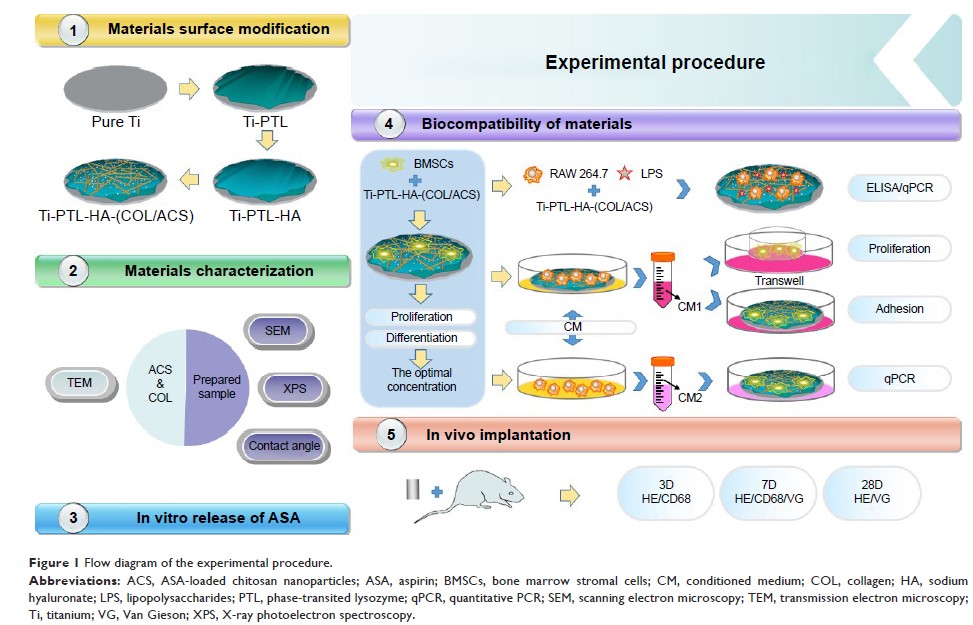108605
论文已发表
注册即可获取德孚的最新动态
IF 收录期刊
- 3.4 Breast Cancer (Dove Med Press)
- 3.2 Clin Epidemiol
- 2.6 Cancer Manag Res
- 2.9 Infect Drug Resist
- 3.7 Clin Interv Aging
- 5.1 Drug Des Dev Ther
- 3.1 Int J Chronic Obstr
- 6.6 Int J Nanomed
- 2.6 Int J Women's Health
- 2.9 Neuropsych Dis Treat
- 2.8 OncoTargets Ther
- 2.0 Patient Prefer Adher
- 2.2 Ther Clin Risk Manag
- 2.5 J Pain Res
- 3.0 Diabet Metab Synd Ob
- 3.2 Psychol Res Behav Ma
- 3.4 Nat Sci Sleep
- 1.8 Pharmgenomics Pers Med
- 2.0 Risk Manag Healthc Policy
- 4.1 J Inflamm Res
- 2.0 Int J Gen Med
- 3.4 J Hepatocell Carcinoma
- 3.0 J Asthma Allergy
- 2.2 Clin Cosmet Investig Dermatol
- 2.4 J Multidiscip Healthc

在配有相转移溶菌酶的钛表面筑造一个载有阿司匹林的骨免疫调节涂层
Authors Zhang W, Lu X, Yuan Z, Shen M, Song Y, Liu H, Deng J, Zhong X, Zhang X
Received 13 October 2018
Accepted for publication 7 January 2019
Published 5 February 2019 Volume 2019:14 Pages 977—991
DOI https://doi.org/10.2147/IJN.S190766
Checked for plagiarism Yes
Review by Single-blind
Peer reviewers approved by Dr Govarthanan Muthusamy
Peer reviewer comments 3
Editor who approved publication: Dr Linlin Sun
Background: To
improve osseointegration and enhance the success rate of implanted
biomaterials, the surface modification technology of bone implants has
developed rapidly. Intensive research on osteoimmunomodulation has shown that
the surfaces of implants should possess favorable osteoimmunomodulation to
facilitate osteogenesis.
Methods: A novel,
green and efficient phase-transited lysozyme (PTL) technique was used to prime
titanium discs with a positive charge. In addition, sodium hyaluronate (HA) and
self-assembled type I collagen containing aspirin (ASA) nanoparticles were
decorated on PTL-primed Ti discs via electrostatic interaction.
Results: The
behaviors of bone marrow stromal cells (BMSCs) on the Ti disc surfaces
containing ASA were analyzed in different conditioned media (CM) generated by
macrophages. Additionally, the secretion of inflammation-related cytokines of
macrophages on the surfaces of different Ti discs was investigated in in vitro
experiments, which showed that the Ti surface containing ASA not only supported
the migration, proliferation and differentiation of BMSCs but also reduced the
inflammatory response of macrophages compared with Ti discs without surface
modification. After implantation in vivo, the ASA-modified implant can
significantly contribute to bone formation around the implant, which mirrors
the evaluation in vitro.
Conclusion: This
study highlights the significant effects of appropriate surface characteristics
on the regulation of osteogenesis and osteoimmunomodulation around an implant.
Implant modification with ASA potentially provides superior strategies for the
surface modification of biomaterials.
Keywords: titanium
surface modification, nanoparticle, osteoimmunomodulation, osseointegration
